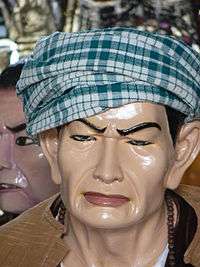Bo Min Gaung
Bo Min Gaung (Burmese: ဘိုးမင်းခေါင်) is a prominent 20th century weizza, or wizard, who lived in Myanmar near Mount Popa[1]. He is associated with Dhammazedi, a prominent king of the Hanthawaddy Kingdom of ancient Myanmar in the 15th century.
History
The history of Bo Min Gaung is unclear. He is said to have lived in the 20th century was successful around 1950 near Mount Popa. He is believed to be born near Mount Popa and lived and practiced meditation and won his success upon occultism there.

The Dhammazedi Gaing consider him as their founder and master, as well as the future Buddha or a future king. However, this is not a standard belief in mainstream Burmese Buddhism. In addition to beleiveing that he will be reincarnated as a powerful leader in the future, the Dhammazedi Gaing also believe that he inhabits the bodies of living persons, whose bodies he speaks through and advises his followers on how to live a Buddhist life[2]. Thus, he is considered as an immortal in traditional Burmese Buddhism and his statues are often featured on Burmese altars[3].
Burmese nationalist movement
Bo Min Gaung is associated with the Burmese nationalist movement[4].
References
- "Late for Nowhere". Retrieved 2019-11-16.
- Spiro, Melford E. (1970). Buddhism and Society: A Great Tradition and Its Burmese Vicissitudes. University of California Press.
- "Myanmar Times, Carving Out a Humble Existence". Retrieved 2019-11-16.
- Skidmore, Monique E. (2005). Burma at the Turn of the Twentieth Century. University of Hawaii Press.
Bibliography
- Spiro, Melford E. (1970). Buddhism and Society: A Great Tradition and Its Burmese Vicissitudes. University of California Press.
- Skidmore, Monique E. (2005). Burma at the Turn of the Twentieth Century. University of Hawaii Press.